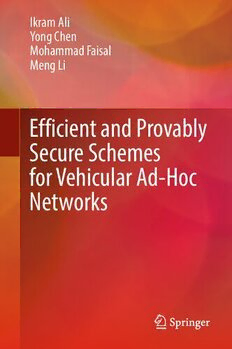Table Of ContentIkram Ali
Yong Chen
Mohammad Faisal
Meng Li
Efficient and Provably
Secure Schemes
for Vehicular Ad-Hoc
Networks
Efficient and Provably Secure Schemes
for Vehicular Ad-Hoc Networks
· · ·
Ikram Ali Yong Chen Mohammad Faisal
Meng Li
Efficient and Provably Secure
Schemes for Vehicular
Ad-Hoc Networks
IkramAli YongChen
SchoolofAutomationEngineering SchoolofAutomationEngineering
UniversityofElectronicScience UniversityofElectronicScience
andTechnologyofChina andTechnologyofChina
Chengdu,Sichuan,China Chengdu,Sichuan,China
MohammadFaisal MengLi
DepartmentofCS&IT SchoolofAutomationEngineering
UniversityofMalakand UniversityofElectronicScience
KhyberPakhtunkhwa,Pakistan andTechnologyofChina
Chengdu,Sichuan,China
ISBN978-981-16-8585-9 ISBN978-981-16-8586-6 (eBook)
https://doi.org/10.1007/978-981-16-8586-6
©TheEditor(s)(ifapplicable)andTheAuthor(s),underexclusivelicensetoSpringerNature
SingaporePteLtd.2022
Thisworkissubjecttocopyright.AllrightsaresolelyandexclusivelylicensedbythePublisher,whether
thewholeorpartofthematerialisconcerned,specificallytherightsoftranslation,reprinting,reuse
ofillustrations,recitation,broadcasting,reproductiononmicrofilmsorinanyotherphysicalway,and
transmissionorinformationstorageandretrieval,electronicadaptation,computersoftware,orbysimilar
ordissimilarmethodologynowknownorhereafterdeveloped.
Theuseofgeneraldescriptivenames,registerednames,trademarks,servicemarks,etc.inthispublication
doesnotimply,evenintheabsenceofaspecificstatement,thatsuchnamesareexemptfromtherelevant
protectivelawsandregulationsandthereforefreeforgeneraluse.
Thepublisher,theauthorsandtheeditorsaresafetoassumethattheadviceandinformationinthisbook
arebelievedtobetrueandaccurateatthedateofpublication.Neitherthepublishernortheauthorsor
theeditorsgiveawarranty,expressedorimplied,withrespecttothematerialcontainedhereinorforany
errorsoromissionsthatmayhavebeenmade.Thepublisherremainsneutralwithregardtojurisdictional
claimsinpublishedmapsandinstitutionalaffiliations.
ThisSpringerimprintispublishedbytheregisteredcompanySpringerNatureSingaporePteLtd.
The registered company address is: 152 Beach Road, #21-01/04 Gateway East, Singapore 189721,
Singapore
Acknowledgements
Firstofall,IwouldliketothankAllahAlmighty,whoenabledmetocompletethis
Book. My sincere most gratitude goes to my academic advisors for their prolific
support,consistentencouragement,guidance,andmotivationduringmystudyatthe
UniversityofElectronicScienceandTechnologyofChina.Iwouldalsoliketothank
myfamilymembers,especiallymylatemotherforrememberingmeinherprayers
andsupportingandencouragingme.Ialsothankmyfriendsandcolleaguesinthe
labfortheirhelpandsupport,withwhomIspentalotofenjoyableandmemorable
time.ThisworkissupportedbytheNationalNaturalScienceFoundationofChina
under grant no. 61973331 and no. 61973257 and the National Key Research and
Development Plan Programs of China under grant no. 2018YFB0106101, and the
ChinaPostdoctoralScienceFoundationundergrantno.2021M690550.
v
Contents
1 Introduction ................................................... 1
1.1 ModesofCommunicationinVANETs ......................... 2
1.2 ChallengesinVANETs ...................................... 3
1.3 StatementoftheWork ...................................... 4
1.4 LiteratureReview .......................................... 4
1.4.1 PKI-BasedSignatureSchemes ......................... 5
1.4.2 IDC-BasedSignatureSchemes ......................... 7
1.4.3 CLC-BasedSchemes ................................. 13
1.5 ObjectivesoftheBook ...................................... 16
1.6 OrganizationoftheBook .................................... 19
References ..................................................... 20
2 Preliminaries .................................................. 27
2.1 PublicKeyCryptography .................................... 27
2.1.1 DigitalSignature ..................................... 27
2.1.2 PublicKeyInfrastructure .............................. 28
2.1.3 Identity-BasedCryptography .......................... 29
2.1.4 CertificatelessCryptography ........................... 30
2.2 Signcryption ............................................... 32
2.3 AnOverviewonVANETs ................................... 33
2.3.1 TypesofAttackers ................................... 33
2.3.2 TypesofAttacks ..................................... 34
2.3.3 SecurityRequirements ................................ 34
2.3.4 PerformanceRequirements ............................ 35
2.4 MathematicalBackground ................................... 35
2.4.1 EllipticCurveCryptosystem(ECC) ..................... 36
2.4.2 BilinearPairing ...................................... 36
2.4.3 ComputationalAssumptions ........................... 37
2.4.4 HashFunctions ...................................... 38
2.5 RandomOracleModel(ROM) ............................... 39
2.6 SecurityNotions ........................................... 39
vii
viii Contents
2.6.1 GoalsoftheAdversary ............................... 39
2.6.2 PoweroftheAdversary ............................... 40
2.7 CryptographicLibraries ..................................... 41
2.8 Summary .................................................. 41
References ..................................................... 41
3 Authentication Scheme for Vehicle-to-Infrastructure
CommunicationsusingBilinearPairing .......................... 43
3.1 SystemModel ............................................. 44
3.2 SecurityRequirements ...................................... 46
3.3 SyntaxandSecurityNotion .................................. 46
3.3.1 Syntax .............................................. 46
3.3.2 SecurityNotion ...................................... 47
3.4 ID-CPPASignatureScheme .................................. 47
3.4.1 Setup ............................................... 48
3.4.2 PIDGen ............................................ 50
3.4.3 KeyGen ............................................ 50
3.4.4 MsgSign ............................................ 51
3.4.5 SigVerify ........................................... 51
3.4.6 BSigVerify .......................................... 52
3.5 SecurityAnalysis ........................................... 53
3.5.1 SecurityProof ....................................... 53
3.5.2 SecurityRequirements ................................ 56
3.6 PerformanceAnalysis ....................................... 59
3.6.1 ComputationalCost .................................. 59
3.6.2 Communication/StorageCost .......................... 63
3.7 Summary .................................................. 64
References ..................................................... 65
4 AuthenticationSchemeforVehicle-to-VehicleCommunications
usingECC ..................................................... 67
4.1 SystemModel ............................................. 68
4.2 SecurityRequirements ...................................... 70
4.3 SyntaxandSecurityNotion .................................. 70
4.3.1 Syntax .............................................. 70
4.3.2 SecurityNotion ...................................... 71
4.4 IDS-CPPAScheme ......................................... 72
4.4.1 Setup ............................................... 72
4.4.2 Vehicle-AID-GenerationandVehicle-Key-Generation ..... 73
4.4.3 Message-Signing .................................... 75
4.4.4 Individual-Signature-Verification ....................... 75
4.4.5 Batch-Signature-Verification ........................... 76
4.5 SecurityAnalysis ........................................... 77
4.5.1 SecurityProof ....................................... 77
4.5.2 SecurityRequirements ................................ 81
4.6 PerformanceAnalysis ....................................... 83
Contents ix
4.6.1 ComputationalCost .................................. 83
4.6.2 Communication/StorageCost .......................... 87
4.7 Summary .................................................. 88
References ..................................................... 88
5 Certificateless Signature-Based Authentication Scheme
forVehicle-to-InfrastructureCommunicationsUsingBilinear
Pairing ........................................................ 91
5.1 SystemModel ............................................. 93
5.2 SecurityRequirements ...................................... 94
5.3 SyntaxandSecurityNotions ................................. 95
5.3.1 Syntax .............................................. 95
5.3.2 SecurityNotions ..................................... 95
5.4 CL-PKSScheme ........................................... 97
5.4.1 Setup ............................................... 97
5.4.2 PIDGen ............................................ 99
5.4.3 PPKGen ............................................ 100
5.4.4 SPKGen ............................................ 100
5.4.5 CLSigGen .......................................... 101
5.4.6 CLSigVerify ........................................ 101
5.5 CL-PKSAggregationandVerification ......................... 103
5.5.1 ACLSigGen ......................................... 103
5.5.2 ACLSigVerify ....................................... 103
5.6 SecurityAnalysis ........................................... 104
5.6.1 SecurityProof ....................................... 104
5.6.2 SecurityRequirements ................................ 111
5.7 PerformanceAnalysis ....................................... 112
5.7.1 ComputationalCost .................................. 112
5.7.2 Communication/StorageCost .......................... 116
5.8 Summary .................................................. 117
References ..................................................... 117
6 AnECC-BasedConditionalPrivacy-PreservingAuthentication
SchemeforVehicle-to-VehicleCommunications ................... 121
6.1 SystemModel ............................................. 123
6.2 SecurityRequirements ...................................... 124
6.3 FrameworkoftheScheme ................................... 125
6.3.1 GenericModel ...................................... 125
6.3.2 SecurityNotions ..................................... 125
6.4 CLSS-CPPAScheme ....................................... 127
6.4.1 Setup ............................................... 127
6.4.2 RegAIDGen ......................................... 128
6.4.3 PSKGen ............................................ 129
6.4.4 SPKGen ............................................ 130
6.4.5 CLSGen ............................................ 130
6.4.6 CLSVerify .......................................... 131
x Contents
6.4.7 BCLSVerify ......................................... 131
6.5 SecurityAnalysis ........................................... 132
6.5.1 SecurityProof ....................................... 132
6.5.2 SecurityRequirements ................................ 137
6.6 PerformanceEvaluation ..................................... 139
6.6.1 ComputationalCost .................................. 139
6.6.2 Communication/StorageCost .......................... 144
6.7 ConclusionandFutureWork ................................. 144
References ..................................................... 145
7 Bilinear Pairing-Based Signcryption Scheme for Secure
Heterogeneous Vehicle-to-Infrastructure Communications
inVANETs .................................................... 147
7.1 SystemModel ............................................. 150
7.2 SecurityRequirements ...................................... 151
7.2.1 MathematicalHardProblemsandAssumptions ........... 151
7.3 FormalFrameworkandSecurityNotions ...................... 152
7.3.1 Framework .......................................... 152
7.3.2 SecurityNotions ..................................... 153
7.4 CPP-HSCScheme .......................................... 154
7.4.1 Setup ............................................... 155
7.4.2 IDC-PIDKG ........................................ 156
7.4.3 PKI-KG ............................................ 156
7.4.4 Signcrypt ........................................... 156
7.4.5 Unsigncrypt ......................................... 157
7.5 SecurityProof ............................................. 159
7.6 PerformanceAnalysis ....................................... 166
7.6.1 ComputationalCost .................................. 167
7.6.2 Communication/StorageCost .......................... 170
7.7 ConclusionandFutureWork ................................. 171
References ..................................................... 171
8 ECC-Based Hybrid Signcryption Protocol for Secure
HeterogeneousVehicle-to-InfrastructureCommunications ......... 175
8.1 SystemModel ............................................. 177
8.1.1 SecurityRequirements ................................ 178
8.2 FormalSyntaxandSecurityNotions .......................... 178
8.2.1 Syntax .............................................. 178
8.2.2 SecurityNotions ..................................... 179
8.3 ECCHSCProtocol .......................................... 180
8.3.1 Setup ............................................... 180
8.3.2 IDC-KeyGen ........................................ 181
8.3.3 PKI-KeyGen ........................................ 182
8.3.4 Signcrypt ........................................... 183
8.3.5 De-Signcrypt ........................................ 183
8.4 SecurityAnalysis ........................................... 185
Contents xi
8.4.1 SecurityProof ....................................... 185
8.4.2 SecurityRequirements ................................ 190
8.5 PerformanceAnalysis ....................................... 191
8.5.1 ComputationalOverhead .............................. 192
8.5.2 Communication/StorageOverhead ..................... 194
8.6 Application ................................................ 197
8.7 ConclusionandFutureWork ................................. 198
References ..................................................... 199
9 CLC- and PKI-based Hybrid Signcryption Scheme
Using Bilinear Pairing for Secure Heterogeneous
Vehicle-to-InfrastructureCommunications ....................... 201
9.1 SystemModel ............................................. 203
9.2 SecurityRequirements ...................................... 205
9.3 ComputationalAssumptions ................................. 205
9.4 FormalFrameworkandSecurityNotions ...................... 205
9.4.1 Framework .......................................... 205
9.4.2 SecurityNotions ..................................... 206
9.5 CP-CPPHSCScheme ....................................... 209
9.5.1 Setup ............................................... 209
9.5.2 CLC-AIDPSKG ..................................... 211
9.5.3 CLC-SPKG ......................................... 211
9.5.4 PKI-SPKG .......................................... 212
9.5.5 SC ................................................. 212
9.5.6 USC ............................................... 212
9.6 SecurityProof ............................................. 214
9.7 PerformanceAnalysis ....................................... 223
9.7.1 ComputationalCost .................................. 223
9.7.2 Communication/StorageCost .......................... 226
9.8 ConclusionandFutureWork ................................. 228
References ..................................................... 228

